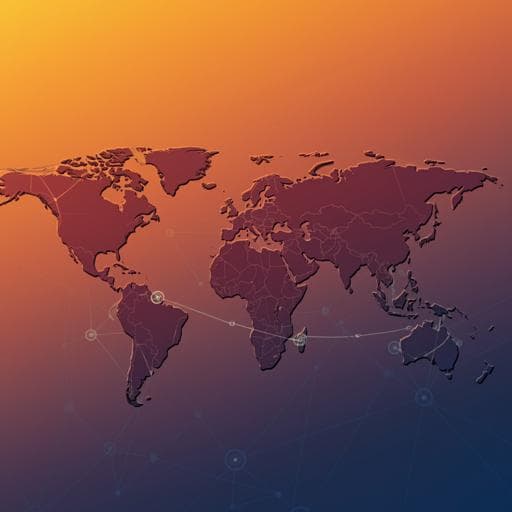
Environmental Studies and Forestry
Environmental-social-economic footprints of consumption and trade in the Asia-Pacific region
L. Yang, Y. Wang, et al.
Explore the significant environmental and socio-economic impacts of Asia-Pacific's rapid growth between 1995 and 2015. This research, conducted by Lan Yang, Yutao Wang, Ranran Wang, Jiří Jaromír Klemeš, Cecília Maria Villas Bôas de Almeida, Mingzhou Jin, Xinzhu Zheng, and Yuanbo Qiao, highlights the region's increasing interdependence in trade and the need for sustainable transformation.
~3 min • Beginner • English
Introduction
The study investigates how growth in economic wellbeing and trade in the Asia-Pacific (APAC) region from 1995 to 2015 affected environmental, social, and economic footprints linked to consumption and trade. APAC occupies a central role in global supply chains and has seen rapid increases in intra-regional exports and major initiatives (e.g., BRI, RCEP) to strengthen trade ties. Despite economic gains, APAC faces severe sustainability challenges, including groundwater overexploitation, high disaster exposure, air pollution-related health burdens, and persistent income inequality, posing risks to achieving the SDGs. Existing consumption-based footprint research often focuses on single indicators, single-year snapshots, or specific large economies, leaving a gap in comprehensive, multi-indicator, APAC-focused analysis. This paper aims to quantify patterns and trends in APAC’s environmental-social-economic footprints, assess intra-regional interdependencies and disparities driven by trade, and evaluate APAC’s evolving role in globalization.
Literature Review
Prior studies developed consumption-based footprint accounting to link consumption with upstream resource use and environmental impacts, but most focus on single indicators (e.g., blue water, energy, carbon, PM2.5, land, labor, material extraction) with occasional multi-indicator analyses (e.g., carbon-land-water, carbon-land-water-material) and often use one-year snapshots rather than time series. Work has concentrated on large economies (US, China, EU), with APAC-specific insights scattered within global analyses of single indicators. Evidence shows developed countries consume carbon-intensive products produced in developing countries and that embedded labor flows disproportionately originate from developing nations. Socioeconomic implications (employment, value added) of consumption have been relatively neglected, creating a gap for holistic sustainability assessments in APAC. Supplementary Table 1 (referenced) provides a brief review.
Methodology
The analysis uses EXIOBASE 3.6, a multi-regional input-output (MRIO) database with 200 product groups across 49 regions, to consistently quantify environmental-social-economic footprints for 1995 and 2015. APAC is represented by Australia, China (mainland), India, Indonesia, Japan, South Korea, Taiwan (China), and the Rest of Asia-Pacific (RoAP). Six indicators span sustainability dimensions: natural resources (blue water consumption, primary energy use), environmental threats (GHG: CO2, CH4, N2O using GWP100; PM2.5 emissions), and socio-economic effects (employment measured as people employed; value added). Footprints of final demand for country/region i in year t are calculated with the Leontief inverse E_ikt = x_it (I − A_t)^{-1} Y_it + F_hh,kt, where A_t is the direct input coefficients matrix and F_hh,kt captures households’ direct contributions. Capital formation is not reallocated to production but treated as part of final demand. Footprint intensity is defined as footprint per unit of final expenditure (constant prices). Trade intensity is defined as direct impacts per unit of gross exports (constant prices), reported for global trade and intra-APAC trade respectively. All computations were performed in Matlab. Data and code are available from corresponding authors upon request.
Key Findings
- Heterogeneity and affluence effects: Footprints per capita vary widely across APAC economies and correlate with affluence. Lower-income countries’ footprints (e.g., India, Indonesia, RoAP, China) increased with poverty alleviation but remained below global averages by 2015. Some evidence supports an Environmental Kuznets Curve for environmental indicators across 1995–2015. Employment and value-added footprints are positively correlated with affluence.
- Outsourcing patterns: High-income APAC economies increasingly outsourced blue water, PM2.5, and labor footprints to other APAC countries. In 2015, 58%, 56%, and 52% of blue water footprints of Japan, South Korea, and Taiwan were traced to other APAC economies via agricultural trade (e.g., sugar, paddy rice). High-income economies’ PM2.5 footprints occurring in other APAC economies rose from ~17% to ~40% (1995–2015). In contrast, 75–99% of PM2.5 footprints for China, India, and Indonesia remained domestic, with a notable share from household fuel use and biomass burning.
- Increased interdependence: Shares of foreign footprints traced to APAC countries rose by 4–27% while domestic shares fell by 3–33% across indicators (excluding compositional changes within aggregated RoAP). India’s footprints remained predominantly domestic (90–99% in 1995; 82–97% in 2015).
- Growth in value-added footprints: Per capita value-added footprints increased most strongly among middle/low-income economies: China +700% (eightfold), India +217%, Indonesia +113%, RoAP +82%, outpacing high-income economies (~+28%).
- Intra-APAC virtual flows (2015): Net bilateral virtual water flows totaled 37 billion m3—~80% exported by RoAP and India; ~50% driven by Japan and South Korea’s final demand. Net energy flow was 15 EJ—China supplied 43% and South Korea 27%; 73% of China’s net energy outflow ultimately served RoAP final demand. Net GHG flows were 488 Tg—76% supplied by China; RoAP’s final demand drove 286 Tg; high-income APAC final demand drove 123 Tg. Net PM2.5 flows were 677 thousand tons—81% occurred in China and India; 38% driven by high-income APAC final demand. Net labor outpouring was 99 million people—RoAP provided 77%; net inflows to Australia (11.4m), Japan (27.6m), South Korea (9.3m), and Taiwan (5.6m). For value added, China became the largest net surplus country by 2015; per capita gains were greatest in South Korea, Australia, Japan, and Taiwan.
- Worsening inequity: From 1995 to 2015, environmental externalities increasingly shifted from higher- to lower-income APAC countries (e.g., >90% of virtual water flows), with PM2.5 disparity worsening. Higher-income countries’ share of economic gains from intra-APAC trade rose from 38% to 59%. China transitioned from a net exporter to a net importer of virtual water (to +5.3 billion m3 by 2015) and from largest net labor supplier to second net demander; India’s net virtual water export rose by 161%.
- APAC’s global role: By 2015 APAC was involved in 50–71% of global virtual flows of water, energy, GHG, PM2.5, labor, and value added embodied in trade. Intra-APAC trade and non-APAC outsourcing to APAC increased (average shares ~17%→20% and ~23%→27%, respectively), while non-APAC-only trade shrank. APAC’s export-related economic gains (27–32%) lagged its exported shares of resources, emissions, and labor (40–48%).
- Intensities and trends: APAC’s footprint intensities (per final expenditure) decreased for water (−30%), PM2.5 (−39%), and employment (−35%), but not for energy (≈0%) and GHG (+2%), relative to 1995. Intra-APAC trade intensities fell for energy (−22%), GHG (−42%), and labor (−34%), but PM2.5 per trade value rose by 7% (global average −34%) as APAC’s PM2.5 trade magnitude nearly tripled. APAC’s intensities remained generally higher than global averages in 2015. China was crucial to improvements: without China, APAC footprint intensities would have increased by ~8% (vs −20% with China), and trade intensity declines would be much smaller (−1% vs −24%).
Discussion
The findings show APAC’s consumption and trade have intensified intra-regional interdependencies while exacerbating environmental and economic disparities, with environmental burdens increasingly shifted to lower-income economies and economic gains accruing more to higher-income economies. APAC’s growing dominance in global embedded flows underscores its central role in managing global resource use and emissions. Although footprint and trade intensities improved, APAC lags behind global averages in energy and GHG footprint intensities and exhibits worsening PM2.5 trade intensity, posing risks to competitiveness as global markets demand lower-carbon products and implement carbon pricing and cap-and-trade. Addressing these challenges requires improving resource and energy efficiency across supply chains, strengthening national actions on energy mix adjustments and emission controls, shifting production locations where appropriate, and promoting eco-innovation. Regional cooperation is essential to reduce imbalances, facilitate technology transfer from leaders (e.g., China) to less-developed APAC economies, and sustain intra-APAC trade and poverty reduction. Failure to prioritize these issues risks undermining APAC’s competitiveness and sustainability.
Conclusion
This study provides a comprehensive, multi-indicator footprint assessment of APAC’s consumption and trade (1995–2015), revealing increased intra-regional interdependence, widening environmental–economic disparities, and APAC’s expanded role in global embedded flows. Despite notable intensity improvements—particularly in water, PM2.5, and labor—APAC still trails global averages for energy and GHG footprint intensities and faces a worsening PM2.5 trade intensity. China’s rapid efficiency gains were pivotal in the region’s progress. Policy priorities should include enhancing resource and energy efficiency, controlling GHG and PM2.5 emissions, aligning with evolving international climate policies, and deepening regional cooperation to reduce imbalances and support technology transfer. Future research should intensify supply chain-wide MRIO analyses to identify sectoral hotspots, evaluate trade-offs and synergies among multiple indicators, and support coordinated policy design for greener, more sustainable APAC supply chains.
Limitations
- Regional aggregation: Smaller APAC economies are combined into a single Rest of Asia-Pacific (RoAP) region due to EXIOBASE country classifications, obscuring country-level details within RoAP.
- Pollution indicator scope: PM2.5 is used as a proxy for local pollution; trends and cross-country patterns may differ for other local environmental indicators (e.g., water eutrophication).
- Temporal coverage: Trend analysis relies on two annual snapshots (1995 and 2015), missing interannual variations that could refine temporal insights.
Related Publications
Explore these studies to deepen your understanding of the subject.







